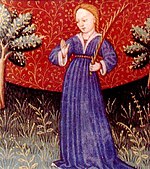Virgo (zodiac)
The zodiac sign Virgo ( Greek παρθένος Parthénos , Latin Virgo ) corresponds to the sixth section of the zodiac from 150 ° to 180 ° ecliptical longitude from the vernal equinox .
The sun is located in this sign on average between August 24th and September 23rd . Due to the migration of the equinox , the zodiac sign Virgo no longer corresponds to the constellation Virgo . In the constellation of Virgo, the sun is roughly between September 17th and October 31st.
After the Tetrabiblos by Claudius Ptolemy
- the virgin is feminine (I.12) and
- the Mercury is rulers of the character (I.17), and
- the Venus is in the Virgin increased (I.19).
As a Melothesian counterpart, in ancient iatroastrology the viscera was assigned to the virgin without the otherwise assigned organs kidneys and spleen . The assigned deity was Ceres .
With Capricorn and Taurus , Virgo forms the trine of the earth element and with Sagittarius , Pisces and Gemini the square of the four communal signs.
The sign was already part of the Babylonian zodiac. It appears on the MUL.APIN boards as “ear of corn” (AB.SIN). It is the ear of corn, which on the one hand corresponds to Spica (Latin corn-ear ), the main star of the constellation, and on the other hand in Greek mythology to the virgin Kore , the daughter of Demeter who was abducted into the underworld and reappeared in spring .
The symbol has been represented since ancient times as a young woman holding a single ear of corn. The origin and interpretation of the astrological symbol are unclear. The resemblance to the symbol of the scorpion is striking . One possible explanation is that it is an old form of the letter "m", which is supposed to refer to the special medical meaning of the sign. A sting was then added to differentiate the scorpion and a curved line was added to the virgin, which in turn symbolizes the ear of corn.
The Unicode character for the symbol is U + 264D (♍).
literature
- Wolfgang Huebner: Zodiac. In: The New Pauly (DNP). Volume 12, Metzler, Stuttgart 2002, ISBN 3-476-01470-3 , Sp. 553-563.

